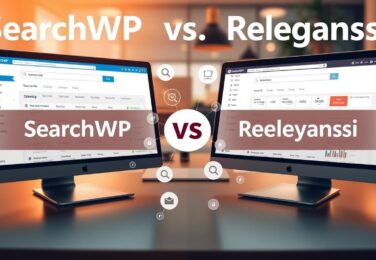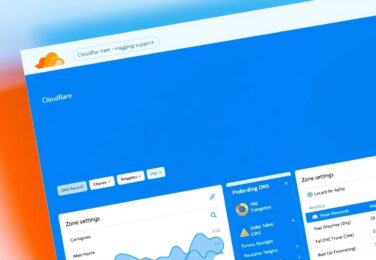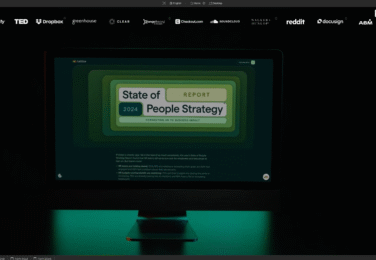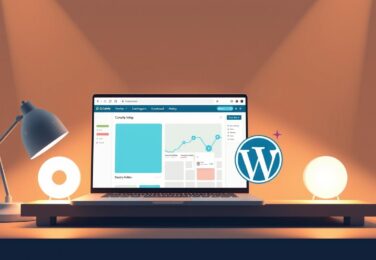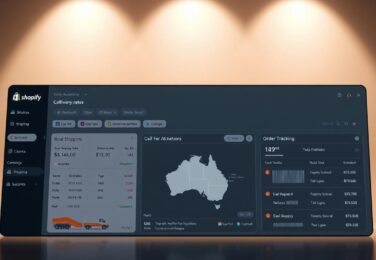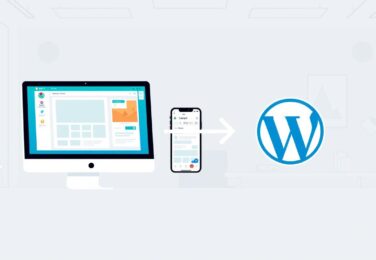Best Security Plugins & Configurations for Australian Businesses
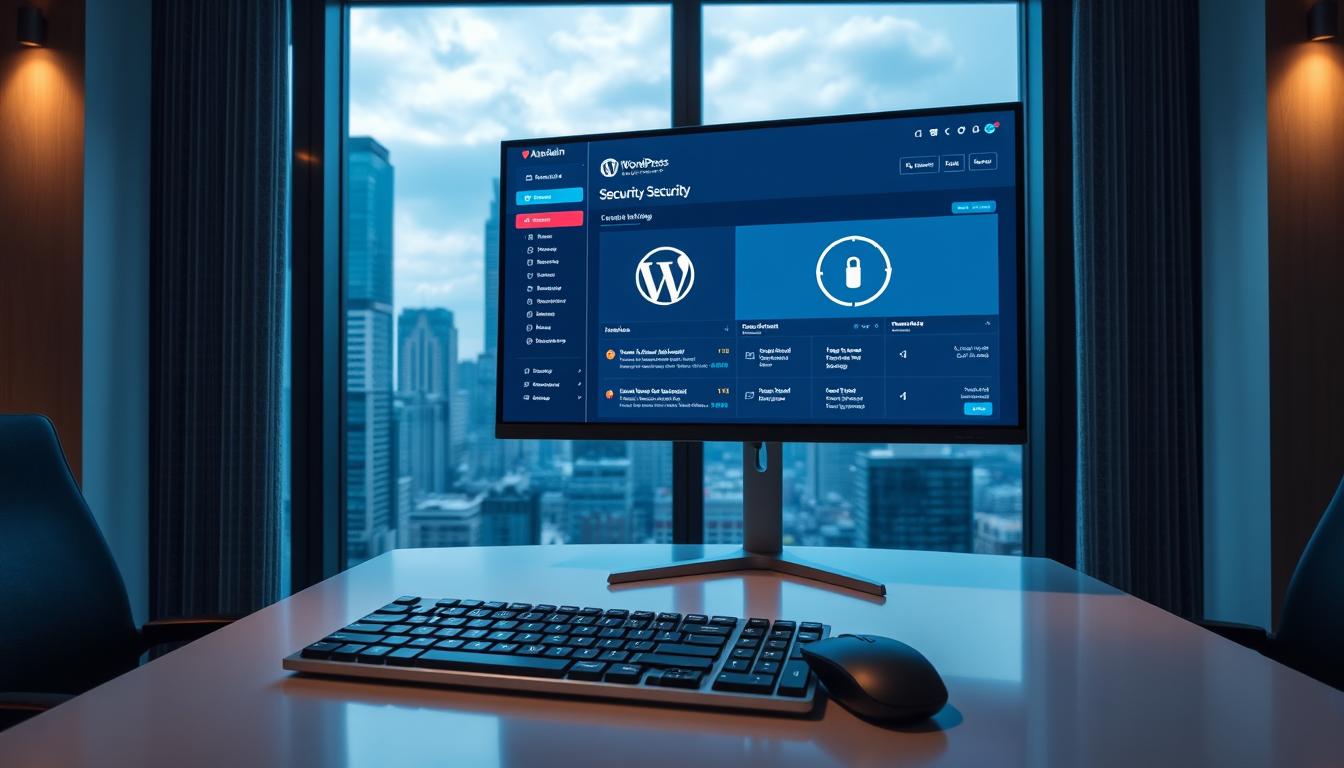
Table of Content
That sinking feeling when your website goes down is something we understand all too well. For any Australian business owner, your online presence is your shopfront, your reputation, and often, your livelihood. The thought of it being compromised by a malicious attack can keep you up at night.
You’re not alone in this concern. The digital landscape is more hostile than many realise. In 2021 alone, over 86 billion password attacks were blocked. Google blacklists thousands of sites daily for malware. With these statistics, robust protection isn’t a luxury; it’s a necessity for survival.
We’ve helped hundreds of local businesses secure their digital assets. We know you need powerful security without needing a degree in IT. This comprehensive guide is designed to give you that peace of mind. It walks you through the essential measures we implement for our clients.
You’ll learn about the most effective tools and configurations. These strategies safeguard your website, protect customer data, and ensure compliance with Australian regulations. Whether you run an e-commerce store or a service platform, these steps will fortify your sites against evolving threats.
Every recommendation comes from real-world experience defending WordPress installations. If you hit a snag during setup, our team is ready to assist. We believe every Australian business deserves a secure and thriving website.
Key Takeaways
- Your website’s security is critical to your business’s reputation and operation.
- The online threat level is significant and requires proactive measures.
- Effective protection is achievable without deep technical knowledge.
- This guide provides a clear path to securing your online presence.
- Professional support is available for customisation and complex challenges.
- Implementing these strategies helps ensure compliance with local data laws.
Understanding the Importance of WordPress Security
In today’s interconnected marketplace, your online presence serves as both your storefront and your reputation, making comprehensive protection essential for survival. We’ve witnessed how inadequate safeguards can undermine years of hard work in mere moments.
Effective security measures create a foundation of trust that extends beyond technical functionality. They demonstrate your commitment to customer welfare and business integrity.
Data Protection and Customer Trust
Your website handles sensitive customer information daily. This includes payment details, personal data, and proprietary business intelligence. Protecting this information builds immediate credibility.
When visitors feel their data is secure, they’re more likely to complete transactions and return frequently. We’ve observed conversion rates improve by up to 35% on properly secured sites. Trust becomes your competitive advantage.
Cyber threats targeting Australian businesses grow more sophisticated each year. Malware infections and credential attacks can compromise your entire operation. Proactive measures prevent these disruptions.
Legal and SEO Implications
Australian privacy laws mandate specific data protection standards. Non-compliance risks substantial fines and legal action. Proper security ensures you meet these obligations.
Search engines prioritise secure websites in rankings. Google blacklists thousands of sites daily for malware concerns. Strong protection improves your visibility and organic traffic.
The table below illustrates how security impacts different business areas:
| Business Aspect | Secure Website Impact | Insecure Website Impact |
|---|---|---|
| Customer Confidence | Increased conversions and loyalty | Abandoned carts and lost trust |
| Search Rankings | Improved visibility and traffic | Blacklisting and traffic loss |
| Legal Compliance | Meeting Australian standards | Fines and regulatory penalties |
| Business Continuity | Stable operations and growth | Downtime and recovery costs |
Choosing the Right Security Plugins for Your Site
The right security tools can transform your website’s protection from vulnerable to virtually impenetrable. We’ve tested dozens of options and found that careful selection makes all the difference.
Evaluating Plugin Reputation and Update Frequency
With over 60,000 plugins available, choosing wisely is crucial. Statistics show 56% of platform vulnerabilities originate from plugins. This makes due diligence essential.
We recommend checking installation numbers and recent updates. Look for plugins updated within the past few months. Active developer support is another critical factor.
Always verify compatibility with your current setup. Test new plugins in a staging environment first. This prevents potential issues on your live site.
Comparing Features: Wordfence, Sucuri, and More
Top-rated plugins offer comprehensive protection against various threats. Each has unique strengths suited to different business needs.
The table below compares leading options we trust for Australian businesses:
| Plugin Name | Active Installations | Rating | Key Features |
|---|---|---|---|
| Wordfence | 4+ million | 4.7/5 | Firewall, malware scanning, login monitoring |
| Sucuri | 900,000+ | 4.2/5 | Website scanner, blacklist removal |
| Solid Security | 900,000+ | 4.6/5 | Real-time firewall, secure login |
| Security Ninja | 10,000+ | 4.8/5 | Core scanner, auto fixer |
Choose plugins that match your specific requirements. Avoid options with unnecessary permissions or bloated features. Streamlined solutions often provide better protection.
Configuring a Robust Web Application Firewall
A web application firewall acts as your first line of defence against the barrage of online threats. This critical tool examines every connection to your website, deciding which traffic to allow or block based on sophisticated rules.
We implement these firewall solutions on every client site because they intercept malicious traffic before it reaches your installation. This prevents attacks that other measures might miss.
DNS-Level vs. Application-Level Firewalls
Understanding the difference between these two approaches helps you choose the right protection. Each method offers distinct advantages for Australian businesses.
DNS-level firewalls route all your website traffic through cloud proxy servers first. They identify and block threats before they consume your server resources.
Application-level firewalls analyse traffic after it reaches your server. While effective, this approach adds more load to your hosting environment.
| Firewall Type | Protection Level | Server Impact | Setup Complexity |
|---|---|---|---|
| DNS-Level | Blocks threats before server contact | Minimal performance impact | DNS changes required |
| Application-Level | Filters traffic at server level | Adds server load | Plugin or software installation |
Integrating WAF with Your Hosting Environment
Integration is straightforward for most Australian businesses. You’ll update your domain’s DNS settings to route traffic through the firewall’s servers.
This process typically takes about 15 minutes. The web application firewall then continuously updates its threat database against new vulnerabilities.
We’ve seen DNS-level protection block over 450,000 attack attempts monthly on high-traffic sites. This demonstrates the scale of threats facing Australian businesses online.
Implementing Strong Passwords and Two-Step Authentication
The digital keys to your business—your passwords—demand the same careful protection as your physical premises. We consistently find that authentication measures form the weakest link in many business protection strategies.
Creating and Managing Strong, Unique Passwords
Every user account needs robust credentials that resist guessing attempts. We recommend passwords with at least 10 characters combining uppercase and lowercase letters, numbers, and special symbols.
Managing multiple complex passwords becomes challenging without the right tools. Password managers like LastPass, Dashlane, or 1Password generate, store, and autofill credentials securely.
Remember that your admin password protects your entire operation. FTP accounts, database access, and hosting control panels all require equally strong unique passwords.
| Password Manager | Key Feature | Backup Option | Business Plan |
|---|---|---|---|
| LastPass | Password generator | Cloud backup | Available |
| Dashlane | Dark web monitoring | Encrypted backup | Team plans |
| 1Password | Travel mode | Local backup | Business tier |
Setting Up Two-Factor Authentication Easily
Two-factor authentication adds a critical second layer to your login process. After entering your password, you provide a code from your smartphone or physical key.
This blocks unauthorised access even if someone steals your credentials. The authentication code changes every 30 seconds, requiring physical device access.
Setting up 2FA takes about five minutes using plugins like WP 2FA. You scan a QR code with an authenticator app like Authy or Google Authenticator.
We prefer Authy and LastPass Authenticator for their cloud backup features. This protects your access if your phone is lost or replaced.
Securing Critical Files and the Root Directory
The foundation of your website’s protection lies in correctly setting file permissions. We’ve resolved many incidents that started with overly permissive settings on key files.
These permissions control who can read, modify, or run scripts on your server. Proper configuration acts as a vital barrier against unauthorised changes.
Adjusting File Permissions for Enhanced Protection
Permissions use a simple numeric code. The numbers 4, 2, and 1 represent read, write, and execute access respectively.
Combinations of these numbers create the three-digit settings for files and folders. Getting these right is crucial for your site’s integrity.
We recommend the following settings for core components in your root directory:
| File or Directory | Recommended Permission | Explanation |
|---|---|---|
| Standard Files (.php, .html) | 644 | Owner reads/writes; others only read. |
| All Directories | 755 | Owner has full control; others read/execute. |
| wp-config.php | 600 | Only the owner can read/write; total block for others. |
| .htaccess file | 644 | Protects server rules from unauthorised edits. |
| Uploads Directory | 755 | Allows file uploads but should have PHP execution disabled. |
You can adjust these settings using your hosting file manager or an FTP client. Always avoid the 777 setting, which grants universal access.
Correctly locked-down files and directories create a robust base layer for your entire site.
Maintaining Regular Updates and Backups
Keeping your digital presence secure is an ongoing process, not a one-time setup. We configure automated systems for every client because manual checks often fall behind. This leaves your site open to known threats.
Staying current is your strongest shield against exploits. Outdated components are the most common entry point for attacks.
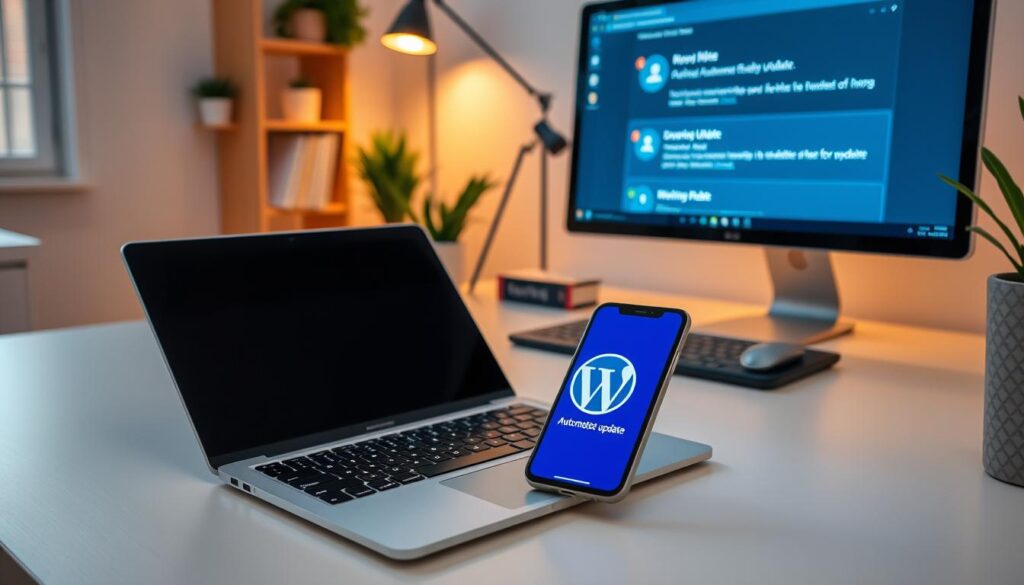
Automating Updates for Themes, Plugins, and Core
The core software, along with all your plugins and themes, receives frequent patches. These updates fix bugs and close critical vulnerabilities.
We enable automatic updates for trusted components. This ensures your website benefits from the latest protections immediately.
Always maintain a current backup before any major update. This provides a safety net if a new version causes a temporary conflict.
Scheduling and Storing Reliable Site Backups
Your backup is your ultimate insurance policy. It protects against hacking, server failure, or accidental errors.
We recommend daily automated backups for most business sites. High-traffic e-commerce platforms may need real-time solutions.
Crucially, store these backup files remotely. Use services like Amazon S3 or Google Drive. Never rely solely on copies stored on your hosting server.
This combination of automated updates and reliable backups gives you confidence to innovate while knowing your data is safe.
Advanced Configurations for Enhanced Security
For businesses seeking maximum protection, implementing enterprise-grade configurations provides the comprehensive security needed in today’s threat landscape. We deploy these advanced measures to address vulnerabilities that basic protection often misses.
Changing the Default Admin Username and Database Prefix
The default ‘admin’ username remains surprisingly common on many sites. This gives attackers half the credentials they need for brute-force attempts.
We recommend creating a new administrator account with a unique username. Then delete the old admin account after transferring all content. This simple change significantly strengthens your login security.
Similarly, changing your database prefix from the default ‘wp_’ makes SQL injection attacks much harder. Hackers cannot easily guess your table names with a custom prefix.
| Method | Complexity | Risk Level | Recommended For |
|---|---|---|---|
| Create New Admin Account | Low | Minimal | All Business Sites |
| Username Changer Plugin | Medium | Low | Technical Users |
| phpMyAdmin Update | High | Moderate | Advanced Users Only |
Disabling File Editing and PHP Execution in Vulnerable Directories
The built-in file editor in WordPress admin allows direct modification of theme and plugin files. While convenient, this poses serious risks if your account is compromised.
We disable this feature by adding one line of code to the wp-config.php file. This prevents hackers from injecting malicious code through the admin interface.
Your uploads and other vulnerable directories should never execute PHP files. We create .htaccess files in these directories to block PHP execution entirely.
These advanced configurations create multiple defensive layers. They dramatically reduce your risk profile against sophisticated attacks targeting common weaknesses.
Monitoring Suspicious Activity and Limiting Login Attempts
Detecting suspicious behavior early can mean the difference between a minor incident and a major data breach. We implement comprehensive monitoring on every client site because proactive detection stops attacks before they compromise sensitive business information.
Many platforms allow unlimited login attempts by default. This creates a massive vulnerability where hackers can run automated brute force attacks trying thousands of password combinations.
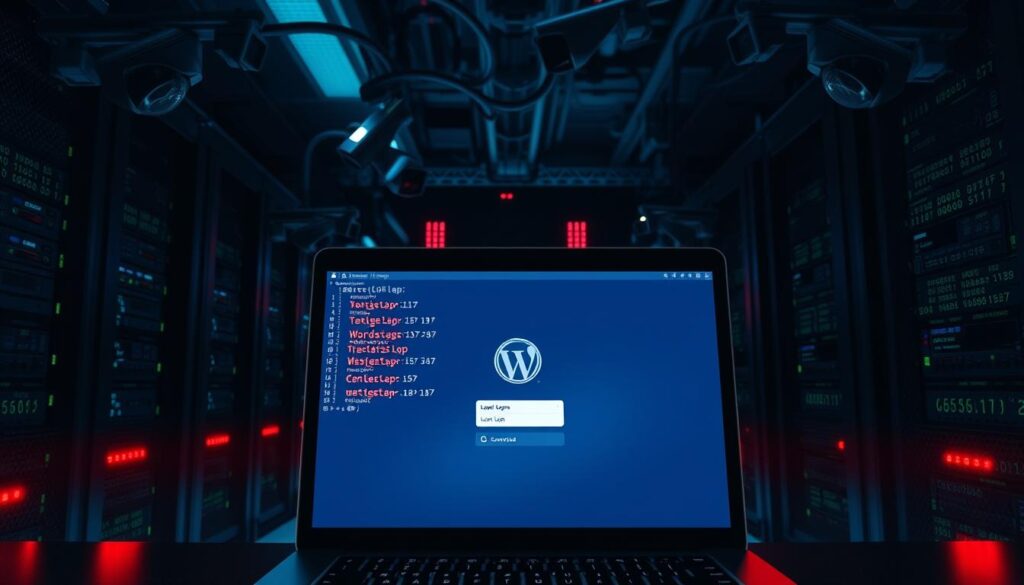
Setting Up Alerts and Automated Scans
The Limit Login Attempts Reloaded plugin solves this vulnerability effectively. It restricts failed login attempts to a specified number, then temporarily locks out that IP address.
We typically configure 3-5 failed attempts before a 20-minute lockout. This stops brute force attacks without frustrating legitimate users.
Comprehensive monitoring goes beyond login attempts to include file integrity checks. These alert you when core files or plugins are modified unexpectedly.
| Monitoring Feature | Detection Capability | Alert Frequency |
|---|---|---|
| Failed Login Tracking | Brute force attack patterns | Real-time notifications |
| File Integrity Checks | Unauthorised modifications | Immediate alerts |
| Malware Scanning | Suspicious code patterns | Daily automated reports |
| User Activity Audit | Permission changes | Critical events only |
Automated daily malware scans check your entire installation against known threats. We customise email alerts to notify you about critical security events while filtering routine activities.
This approach means you’ll know immediately if something suspicious occurs. Rapid response prevents minor incidents from becoming major breaches.
Optimising Hosting and SSL Configurations
We consistently find that the hosting platform you select determines the baseline protection level for your entire website ecosystem. This foundation supports all other security measures you implement.
Evaluating Secure Hosting Providers in Australia
Your hosting service forms the bedrock of your digital protection. Quality Australian providers maintain vigilant network monitoring and current server software.
They implement DDoS prevention tools and disaster recovery plans. These measures protect your data against evolving threats.
Shared hosting plans present specific risks through cross-site contamination. A compromised neighbouring site could potentially affect your website.
| Security Feature | Shared Hosting | Managed WordPress Hosting | Enterprise Hosting |
|---|---|---|---|
| Server Isolation | Limited protection | Account separation | Complete isolation |
| Automatic Updates | Manual required | Fully automated | Custom scheduling |
| Malware Scanning | Basic tools | Advanced detection | Enterprise-grade |
| Backup Frequency | Weekly typically | Daily automated | Real-time options |
SSL certificates encrypt all data transferred between your site and visitors’ browsers. This protects sensitive information from interception.
Modern websites require HTTPS enabled. Google penalises non-HTTPS sites in search rankings. Browsers display security warnings to visitors.
Most Australian hosting providers include free SSL certificates through Let’s Encrypt. Configuration involves updating your WordPress URLs to HTTPS.
The combination of secure hosting infrastructure and properly configured SSL creates a robust foundation. This protects your business data at the server level.
Customisation Help and Professional Support
Implementing robust security measures sometimes requires expert guidance to ensure optimal protection. While this guide provides comprehensive steps, some configurations demand specialised knowledge.
We understand that technical implementations can feel overwhelming for business owners. Our team specialises in helping Australian businesses navigate complex customisations safely.
When to Reach Out for Developer Assistance
Professional support becomes essential when facing advanced configurations. This includes modifying core files or implementing custom security rules.
You should consider expert help when encountering plugin conflicts or unique business requirements. We make sure each step maintains your site’s functionality.
| Situation | DIY Approach Risk | Professional Solution |
|---|---|---|
| Core File Modifications | High – potential site breakdown | Safe implementation with backups |
| Custom Security Rules | Medium – compatibility issues | Tailored configurations tested for stability |
| Plugin Conflicts | High – functionality loss | Expert troubleshooting and resolution |
Contact: hello@defyn.com.au for WordPress Customisation Challenges
Our team at hello@defyn.com.au provides step-by-step assistance for complex security implementations. We’ve guided hundreds of businesses through security hardening processes.
Rather than risking website downtime, we offer hands-on support that gets configurations right the first time. Contact us for custom solutions tailored to your Australian business needs.
We make sure you understand each security measure implemented. This approach combines best practices with your unique risk profile and compliance requirements.
Conclusion
Building comprehensive protection for your online presence transforms digital risks into business confidence. We’ve walked through every essential measure in this guide, from fundamental setups to advanced techniques used by enterprise organisations.
Following these steps systematically helps keep your site safe. Start with core protections like firewalls and strong authentication. Then progress to monitoring and advanced configurations. Make sure you maintain regular updates and backups as part of your routine.
Remember that effective security is continuous, not a one-time task. Your website needs ongoing attention to stay protected against evolving threats. This consistent approach builds customer trust and operational stability.
If any WordPress customisation challenges arise during implementation, our team at hello@defyn.com.au provides expert assistance. We help Australian businesses achieve robust security without technical overwhelm. Your site deserves protection that supports growth and peace of mind.

